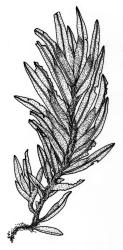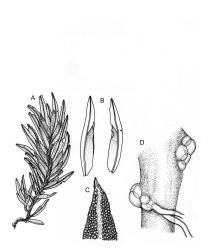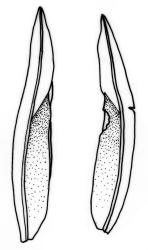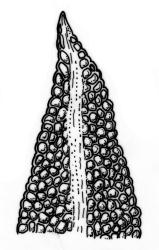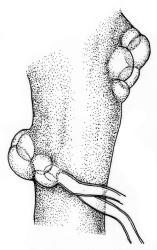- ≡ Fissidens robinsonii Broth., Philipp. J. Sci., C 13: 204 (1918)
Plants up to 10 mm, yellow-green. Stems frequently branched, with axillary hyaline nodules well-developed, rhizoids at branch bases and associated with axillary nodules, cross-section with central strand. Leaves in 20–30(–35) pairs, overlapping at mid stem, erect-spreading, decurved when moist, apices inrolled towards the substrate when dry, linear-lanceolate, 1.4–1.8 × 0.18–0.24 mm; apex acuminate; laminae unistratose; vaginant laminae ½–⅔ leaf length, closed; dorsal lamina variable at base; margins minutely serrulate near leaf apex, serrulate-crenate on apical, dorsal and vaginant laminae, with cells of supra-basal margins of vaginant laminae isodiametric to oblate; cells of apical and dorsal laminae irregularly hexagonal, smooth, strongly bulging, with moderately thick walls, (6.0–)7.0–8.0(–9.0) × (5.0–)6.5–7.5(–9.0) µm. Costa percurrent to shortly excurrent, taxifolius-type in cross-section.
Dioicous? Perichaetia terminal, with perichaetial leaves little differentiated. Perigonia and capsules not seen.
Li 1985, fig. 16, l–t (as F. robinsonii); Li & Iwatsuki 2001, pl. 77, 1–14.
This moss is the only N.Z. member of subgen. Pachyfissidens sect. Crispidium, a small section consisting of five or six species found in Africa, Malesia, Australasia, and Oceania (Pursell & Bruggeman-Nannenga 2004).
Fissidens crispulus var. robinsonii is said to differ from the type variety in its narrowly acute leaf apices, with short excurrent costae (IIwatsuki & Suzuki 1989, as varieties of F. zippelianus), and in the presence of a differentiated central strand in the stem (Li & Iwatsuki 2001). N.Z. material matches well the lectotype of F. robinsonii Broth., and, although scanty, is placed with confidence into F. crispulus var. robinsonii.
Fissidens crispulus var. robinsonii is unique among N.Z. species in having the conspicuous axillary hyaline nodules characteristic of subgen. Pachyfissidens sect. Crispidium. These are visible on the stem when leaves are removed. The intact moist shoots are reminiscent of both F. pallidus and F. capitatus, particularly in leaf shape and stance, but can be distinguished by the percurrent to shortly excurrent costae. When dry, young leaves of F. crispulus var. robinsonii curl strongly toward the substrate. This gives an impression of the whole apical portion of the shoot curling downwards. In contrast, dry shoots of F. pallidus and F. capitatus tend to have individual leaves curled away from the substrate.
K.
Anomalous. New Caledonia*. Reported from Oceania, e.g., Vanuatu by Suzuki & Iwatsuki (2002), and widely from Asia, e.g., China by Li & Iwatsuki (2001), Philippines by Tan & Iwatsuki (1991), and Peninsular Malaysia by Tan & Meng-Shyan (2002).
Australian records of F. crispulus s.l. are limited to Queensland (Streimann & Klazenga 2002). Thus, although the species should be searched for in the northern North I., it may be at its southern N.Z. limit in the Kermadec Is.
Known in N.Z. from a very few scanty specimens from Raoul I. in the Kermadec Is, collected by P.J. de Lange and D. Havell (K121, CHR 624175; K74, AK 325964). At one site the moss grew on a shaded "dripping wet rock face" associated with F. asplenioides and Cyclodictyon blumeanum; at another, plants were "on silt and mud accumulated at the base of a rotational slump", with only the tips of their shoots exposed; at a third site they grew "on muddy andesitic silt and pumiceous sand lodged between boulders". In all three specimens the moss leaves are heavily encrusted with a filamentous cyanobacterium.
Elevations range from 150 to 320 m.
The species is classified as "Data Deficient" in the N.Z. Threat Classification System (Glenny et al. 2011).



